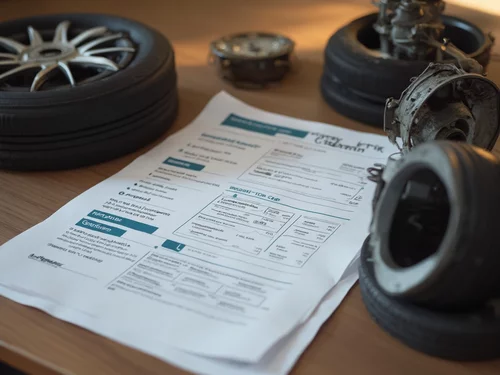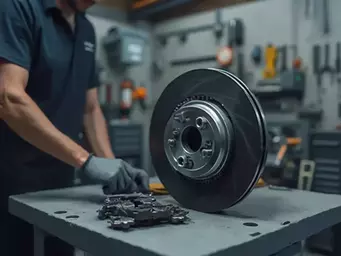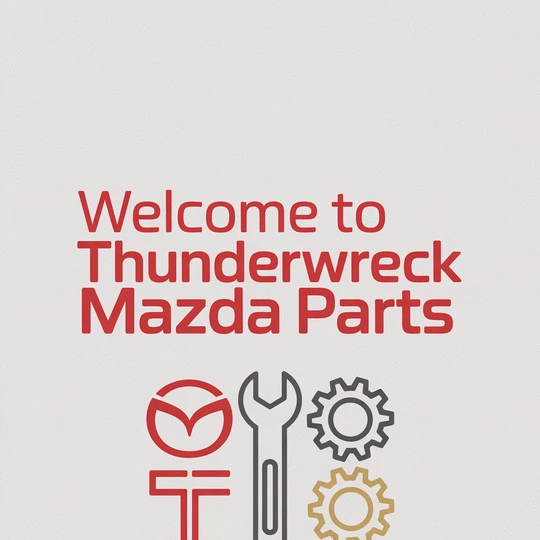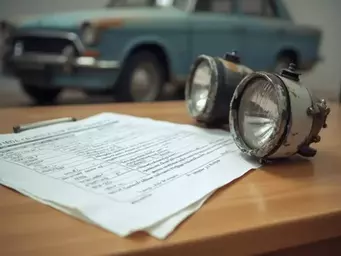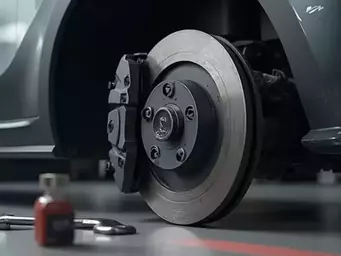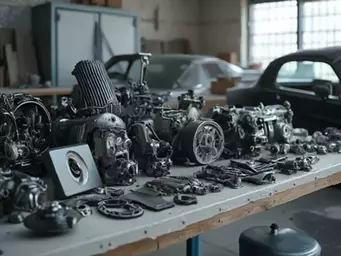Did you know that understanding a vehicle condition report can significantly impact your decision-making when purchasing used Mazda parts? By familiarizing yourself with these essential documents, you can save money and avoid costly mistakes!
What You Will Learn
- The importance of vehicle condition reports for transparency and informed purchasing decisions.
- Key components to look for in both exterior and interior assessments of vehicles.
- Common mechanical and electrical issues specific to Mazda models to watch out for during inspections.
- How to interpret each section of the report, including indicators of mechanical integrity and maintenance history.
- The value of independent inspections to ensure unbiased evaluations and build trust in the buying process.
- The benefits of using templates and annotated sample reports to enhance your understanding of vehicle condition reports.
- Advice on choosing between OEM and aftermarket parts based on quality and cost considerations.
Key Components of a Vehicle Condition Report
A vehicle condition report for used Mazda parts focuses on several critical areas to ensure quality and transparency. Below are the key components, divided into distinct sections for clarity.
Exterior Assessment
- Paint condition (scratches, chips, fading)
- Body damage (dents, rust, misaligned panels)
- Glass (cracks in windows/windshield)
Interior Inspection
- Upholstery condition (tears, stains, wear)
- Functionality of controls (switches, knobs)
- Odor issues (hidden problems)
Mechanical & Electrical
- Engine performance (wear, potential issues)
- Transmission operation (smooth shifting)
- OBD2 codes (vehicle health insights)
Common Mazda Issues
- Engine problems (oil leaks, smoke)
- Transmission issues (slipping gears, noises)
- Electrical faults (windows, lights)
The Essential Guide to Vehicle Condition Reports for Used Mazda Parts
When it comes to purchasing used Mazda parts, understanding the vehicle condition report is crucial. This report provides a comprehensive overview of the vehicle's state, helping you make informed decisions about the parts you need. Not only does it outline the overall health of the vehicle, but it also highlights potential issues that could affect your purchase. As an automotive enthusiast, I can’t stress enough how essential it is to have this knowledge before diving into the used parts market!
The significance of a vehicle condition report lies in its ability to give you transparency. This helps you gauge whether the parts you're considering will meet your needs. At ThunderWreck Mazda Parts, we encourage every Mazda owner to familiarize themselves with these reports to ensure they get the best quality parts while saving money.
Understanding the Purpose of a Vehicle Condition Report
A vehicle condition report serves as a snapshot of a car’s physical and mechanical state. This document is particularly important for those looking for secondhand Mazda parts, as it can reveal hidden issues that may not be visible upon casual inspection. The report effectively communicates whether a vehicle has been well-maintained or if it’s seen better days. For example, federal regulations like those outlined by the FMCSA on Driver-Vehicle Inspection Reports highlight the importance of detailed assessments to ensure vehicle safety and operational integrity.
- Transparency: It allows buyers to see the true state of the vehicle.
- Informed Decisions: Helps in making choices that align with your needs and budget.
- Trust Building: Establishes a reliable relationship between buyers and sellers.
A clear understanding of this report can save you from purchasing defective parts that could lead to costly repairs down the line. So, if you’re ready to dive deeper into your Mazda's potential needs, let’s explore what a solid vehicle condition report should include!
Key Components of a Vehicle Condition Report
Exterior Assessment: What to Look For
When assessing the exterior of a vehicle, there are several key factors to consider. As a Mazda owner, you’ll want to look for signs of previous accidents or repairs, such as uneven paint or misaligned panels. Pay attention to the following:
- Paint condition: Look for scratches, chips, or fading.
- Body damage: Check for dents or rust, especially around the wheel wells.
- Glass: Inspect for cracks in the windows or windshield.
These elements can give you a clear picture of the vehicle’s history and how it might affect the parts you are looking to purchase. Always remember, a thorough exterior inspection can save you headaches later on!
Interior Inspection Insights
The interior of a Mazda is just as important as the exterior, particularly for assessing seats, dashboard components, and electronics. When you evaluate the interior, here are some aspects to keep in mind:
- Upholstery condition: Look for tears, stains, or signs of wear.
- Functionality of controls: Test switches and knobs to ensure everything works smoothly.
- Odor issues: Be mindful of any unpleasant smells that might indicate hidden problems.
Taking the time to inspect the interior can help you identify potential red flags and evaluate whether the parts needed from this vehicle will meet your expectations. Regulations like those from California Code of Regulations (13 CCR § 1215) often specify detailed requirements for vehicle inspections, including interior components, to ensure safety and compliance.
Mechanical and Electrical Systems Overview
Understanding the mechanical and electrical systems is vital for ensuring the components you’re considering are in good shape. The vehicle condition report should include details on key areas like:
- Engine performance: Look for indicators of wear or potential issues.
- Transmission operation: Ensure smooth shifting without delay.
- OBD2 codes: These can provide insights into the vehicle’s health and any underlying issues.
Grasping these mechanical aspects can be a game-changer for Mazda owners. It gives you the confidence that the parts you are investing in will function as required, maximizing your vehicle's performance!
Common Issues to Watch for in Mazda Models
Every car model comes with its own set of common issues, and Mazdas are no exception. Some prevalent mechanical problems to be aware of include:
- Engine problems: Check for oil leaks or excessive smoke.
- Transmission issues: Be alert for slipping gears or unusual noises.
- Electrical faults: Monitor for issues with power windows or lights.
By keeping an eye out for these specific issues, you can make better choices when selecting used parts from ThunderWreck Mazda Parts, ensuring your Mazda runs smoothly for years to come.
How to Interpret Each Section of the Report
Decoding Paint Condition and Body Damage
Interpreting the condition of the paint and body requires a keen eye. Look for signs of repair work, such as overspray or mismatched paint. Understanding these clues can help you gauge the vehicle's history and how it’s been treated over time.
Evaluating Mechanical Integrity and Performance
When it comes to mechanical integrity, focus on the indicators presented in the report. This includes evaluating engine health based on mileage and previous service history. A well-documented report can steer you clear of potential issues, aiding in your decision-making process.
Understanding Vehicle Maintenance and Service Records
The vehicle’s maintenance history can significantly influence your purchasing decision. Look for records that signify regular check-ups and repairs. A car that’s been well-maintained is likely to have fewer hidden issues, making your investment in used parts more reliable.
The Value of Using Vehicle Condition Reports
Avoiding Defective Purchases Through Informed Decisions
Utilizing vehicle condition reports can help you avoid purchasing defective parts. By having a clear understanding of the vehicle's condition, you can mitigate risks and enhance your chances of acquiring quality secondhand parts.
Independent Inspections: Why They Matter
Independent inspections are essential for unbiased evaluations. They ensure that the vehicle condition report is accurate and comprehensive, giving you peace of mind when you’re ready to buy. Trust is key in the used parts market, and relying on third-party assessments can add an extra layer of assurance. The CSA Safety Planner provides guidelines on conducting thorough vehicle inspections, emphasizing their role in overall vehicle safety and compliance.
Tools and Resources for Reading Vehicle Condition Reports
Templates and Digital Assistance
There are various tools available to assist you in generating and understanding vehicle condition reports. Utilizing templates specifically designed for Mazda can streamline the inspection process, making it easier to document findings effectively.
Annotated Sample Reports for Reference
Visual examples can be incredibly helpful when learning to interpret vehicle condition reports. Annotated sample reports can provide clarity, allowing you to recognize the essential components and what to look for in real-world scenarios.
Using Car History Reports to Verify Condition
Car history reports are invaluable when assessing a vehicle’s past. They can provide insights into accident history, previous ownership, and maintenance records. Make sure to integrate this information with the vehicle condition report to get the complete picture before making your purchase.
Choosing Between OEM and Aftermarket Parts
Finally, deciding between OEM (Original Equipment Manufacturer) and aftermarket parts is a significant consideration. Here’s a brief overview of the pros and cons:
- OEM Parts: Typically offer quality assurance and compatibility but can be more expensive.
- Aftermarket Parts: Often more affordable and available in a range of options, but quality can vary.
As someone dedicated to providing high-quality secondhand Mazda parts, I always recommend weighing these factors carefully. At ThunderWreck Mazda Parts, we strive to offer both OEM and reliable aftermarket options to suit every driver’s needs! So, whether you choose OEM or aftermarket, ensuring you have the right part is essential!
Pro Tip
When inspecting a vehicle condition report, always pay close attention to the maintenance history. A well-documented service record can indicate that the vehicle has been cared for, reducing the likelihood of hidden issues. Don’t hesitate to ask for clarification on any maintenance entries that seem vague or incomplete!
Frequently Asked Questions (FAQs)
- What is a vehicle condition report?
- A vehicle condition report is a comprehensive document that provides an overview of a vehicle's physical and mechanical state, helping buyers make informed decisions about purchasing used parts.
- Why is a vehicle condition report important for buying used Mazda parts?
- It offers transparency by revealing the true condition of the vehicle and its components, helping you avoid defective parts and potential costly repairs.
- What key areas should I examine in a vehicle condition report?
- You should examine the exterior (paint, body damage, glass), interior (upholstery, controls, odors), and mechanical/electrical systems (engine, transmission, OBD2 codes).
- Are there specific issues I should look for in Mazda models?
- Yes, common Mazda issues include oil leaks or excessive smoke from the engine, slipping gears or unusual noises from the transmission, and electrical faults like issues with power windows or lights.
- How can maintenance records help me when reviewing a report?
- Maintenance records show regular check-ups and repairs, indicating a well-maintained vehicle with fewer hidden issues, which makes your investment in used parts more reliable.
- What is the benefit of an independent inspection?
- Independent inspections provide unbiased and accurate evaluations of the vehicle's condition, giving you peace of mind and an extra layer of assurance in the used parts market.
- Should I choose OEM or aftermarket parts?
- OEM parts offer guaranteed quality and compatibility but are often more expensive. Aftermarket parts are usually more affordable and varied, but their quality can differ. Your choice depends on your budget and quality requirements.
Conclusion: Making Informed Decisions with Vehicle Condition Reports
Understanding vehicle condition reports is crucial for anyone looking to purchase used Mazda parts. These reports provide valuable insights into the condition of the parts you’re considering, allowing you to make informed decisions that can save you money and headaches down the line. With a thorough understanding of what to look for, you can ensure that you’re getting quality components that will keep your Mazda running smoothly.
As a Mazda enthusiast myself, I can’t stress enough how important it is to be well-informed. Having the right knowledge helps you avoid costly mistakes and ensures your vehicle remains in top-notch condition. So, let’s recap some essential points to guide your purchasing journey!
- Familiarize yourself with the major components of a vehicle condition report.
- Pay close attention to common issues specific to Mazda models.
- Always ask for maintenance and service records before making a decision.
- Consider independent inspections for unbiased evaluations.
Next Steps: Utilizing Your Knowledge Effectively
Now that you have a solid grasp of vehicle condition reports, it’s time to put that knowledge into action! Start by reviewing any reports you come across and critically assess the information presented. Create a checklist of the factors that matter most to you when evaluating used Mazda parts. This will help streamline your search and empower you to make decisions that align with your needs and budget.
Additionally, don’t hesitate to reach out to trusted suppliers like ThunderWreck Mazda Parts for personalized advice. We’re always here to help you navigate the world of used parts and provide the best solutions for your Mazda!
Join the Conversation: Share Your Experiences
I’d love to hear from you! Have you recently purchased used Mazda parts and utilized a vehicle condition report? What tips do you have for fellow Mazda owners? Sharing your experiences can help others in our community make informed choices. Leave a comment below and let's keep the conversation going!
Recap of Key Points
Here is a quick recap of the important points discussed in the article:
- Familiarize yourself with the major components of a vehicle condition report to ensure quality parts.
- Pay close attention to common issues specific to Mazda models, such as engine and transmission problems.
- Always ask for maintenance and service records before making a purchase to verify the vehicle's history.
- Consider independent inspections for unbiased evaluations of the vehicle's condition.
- Utilize car history reports in conjunction with vehicle condition reports for a comprehensive understanding of the vehicle.

